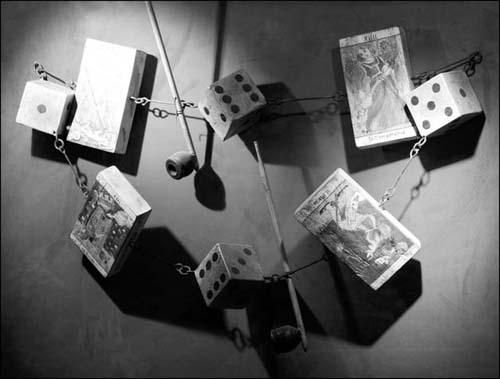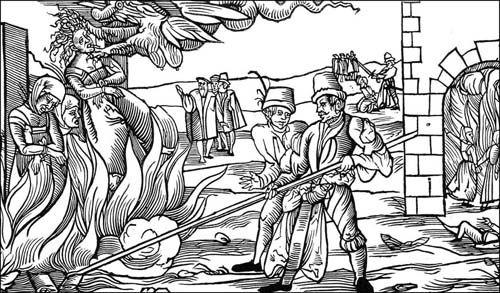The Big Book of Pain: Torture & Punishment Through History (21 page)
Read The Big Book of Pain: Torture & Punishment Through History Online
Authors: Daniel Diehl


Until the end of the eighteenth century, European urban and suburban panoramas abounded in iron and wooden cages attached to the outsides of town halls and ducal palaces, to halls of justice, to cathedrals and to city walls. The naked or nearly naked victims were locked into the cages and hung up. They perished of hunger and thirst, a fate seconded in winter by storm and cold, in summer by heatstroke and sunburn; often they had been tortured and mutilated, to make more edifying examples. The putrefying cadavers were generally left in place until the bones fell apart.
Charles I succeeded his father, James, in 1625, bringing with him new ideas. Some of these, like the king’s insistence on ruling without having to consult Parliament, were annoyingly old-fashioned, but his thoughts on crime and punishment were both enlightened and liberal. Branding was greatly diminished, as were a number of other forms of corporal mutilation. Torturing a prisoner to obtain a confession was outlawed – although it was never legal under the terms of Magna Charta – and almost immediately hangings at Tyburn dropped from 150 or so per year to around ninety. Unfortunately for Charles, Parliament was no more impressed with liberal laws than they were with the king ruling behind their collective back. Both the judiciary and Parliament were now packed with reactionary, fundamentalist Puritans who had no intention of liberalising anything. In 1634, a Quaker Member of Parliament, William Prynne (Quakers being far too liberal to suit the Puritans) was sentenced to life in prison for his faith. A part of his sentence was to be pilloried, to have both ears cut off and branded with the letters S.L., for ‘seditious libeler’. Another Quaker, Anne Auckland, was sentenced to eight months’ imprisonment in an underground sewer and James Parnell was imprisoned in a hole in a wall 12ft above the ground. Torture to obtain a confession may have been outlawed by King Charles, but torture as punishment remained standard operating procedure under the Puritans.

An instrument of public ridicule, the gambler’s rosary was reserved in some places for smokers and gamblers who, thus ornamented, were exposed in the market square, subject to the usual consequences – at the very least embarrassing – but frequently painful, sometimes serious, and even fatal. Similar ‘necklaces’ made of heavy wooden or stone ‘bottles’, or equally onerous ‘balance weights’ or huge ‘coins’ were hung around the necks of, respectively, drunkards and dishonest shopkeepers. Poachers were known to be decked out with chains to which the cadavers of their ill-got prey were strung and left until they putrefied and fell apart (particularly effective in the summertime) – but only after having the first and second finger of their right hand cut off so that they could no longer draw an arrow (or later pull a trigger on a musket).
In the early 1640s, Parliamentary forces seized control of the government and declared open war on the king. Even while Civil War raged across England, Parliament took time to enact draconian laws against anything that seemed to contravene the strict Puritan moral code. Sex outside the marriage bed became a crime, and adultery was declared a felony. By 1648 anyone convicted of being a theatrical actor could be publicly flogged and anyone caught attending a play could be fined. Cock-fighting was also outlawed; not because it was cruel, but because it was ‘commonly accompanied by [betting], drinking and swearing’. Soon, anyone caught having fun of any kind could expect to be stocked, pilloried and/or whipped to within an inch of their lives.

Swearing, blaspheming, playing cards or dice, doing business on Sunday, failure to attend church or even ‘vainly or profanely walking on the Lord’s Day’ were all liable to a heavy fine and public punishment. When a non-Puritan fanatic named James Naylor insisted he was God and that it was permissible for an unmarried couple to have sex so long as they went to the same church, he was sentenced to the following punishment: first he was pilloried in Palace Yard, then whipped through the streets of London all the way to the Old Corn Exchange. Two days later he was again pilloried at the Corn Exchange before having a hole bored through his tongue and being branded with a ‘B’ for blasphemer. He was then carted to the town of Bristol where he was again flogged and placed in solitary confinement, at Bridewell Prison, for an unspecified period of time.
Parliament began the next year of judicial progress – 1649 – by beheading King Charles and setting up a new government under Oliver Cromwell who, in order to better torture everyone in England, promptly closed the taverns. Like all dictators before and since, Cromwell and the Puritans needed a bogeyman to keep the people frightened into obedience. They already had Catholics and closet-monarchists, but they needed something more general – a blanket fear that would keep every man and woman in England shaking in their boots. The perceived threat of witches serving as agents of the devil seemed to fit the demand admirably.
Witchcraft had always been feared as an enemy of Christianity but it had not been until 1484 that Pope Innocent VIII had made the persecution of witches a doctrine of the faith. The same year that he allowed Spain to set up its own Office of the Inquisition he issued a Papal Bull on witchcraft. In it, he said:
It has indeed lately come to our ears, not without afflicting us with bitter sorrow, that … many persons of both sexes, unmindful of their own salvation and straying from the Catholic faith, have abandoned themselves to devils, incubi and succubi [male and female demon spirits] … and at the instigation of the enemy of mankind they do stink from committing and perpetrating the foulest abominations and filthiest excesses to the deadly peril of their own souls, whereby they outrage the Divine Majesty and are cause of scandal and danger to very many. … In virtue of Our Apostolic authority We decree and enjoin that … Inquisitors be empowered to proceed to the just correction, imprisonment and punishment of any persons … designated in Our letters.
Frightening as this Papal Bull is, there was ample religious authority to back it up. In Exodus 22:18 it says: ‘Thou shalt not suffer a witch to live’ and no less a respected figure than St Thomas Aquinas had preached against the evils and dangers of witchcraft.
To help win the fight against the satanic legions, Pope Innocent appointed two German Dominican monks, Heinrich Kraemer and Johann Sprenger, to carry out enquiries in northern Germany where witchcraft seemed to be particularly rampant. Kraemer and Sprenger were uniquely qualified to fulfil their new assignment; they were cunning enough to twist both secular and Canon Law to whatever end they desired, they were dyed-in-the-wool fanatics and they hated women vehemently. During the course of their investigations, Kraemer and Sprenger compiled a book that would serve as the guide for all witch hunters to follow – the
Malleus Maleficarum
, or ‘Hammer of Witches’. Actually its full title reads: ‘
MALLEUS MALEFICARUM, Maleficas, & earum hæresim, ut phramea potentissima conterens.
’ This translates as: ‘The Hammer of Witches which destroyeth Witches and their heresy like a most powerful spear.’

This woodcut depicts three women convicted of witchcraft being burned alive while the devil flies into or out of one of their mouths. As horrific as this scene would have been to witness, we must remember that this method of execution was seen by contemporaries as merciful in the sense that the torments of the flames endured here on earth were thought to help with the victim’s chances of eternal salvation. Note also the ‘witches sabbath’ on the right and the comparatively merciful beheading in the background.
In addition to guiding witch hunters through the process of enquiry and torture, the
Malleus
identified precisely how witchcraft worked. ‘All witchcraft comes through carnal lust which is insatiable in women, wherefore for the sake of fulfilling their lusts they consort with devils’. According to Kraemer and Sprenger, the Devil appeared to women in any form they might find sexually pleasing and thereby seduced them into becoming his servants.
The authors of the
Malleus
, as well as other writers, quickly expanded on their concept of just how dangerous witches could be:
they raise hailstorms and hurtful tempests and lightning; cause sterility in men and animals; offer to devils, or otherwise kill, those children whom they do not devour. [They] make horses go mad under their riders; they can transport themselves from place to place through the air … they can affect Judges and magistrates so that they cannot hurt them; they cause themselves and others to keep silent under torture …
Naturally, to be capable of so much evil the witches had to be organised and thus the concept of the witches’ Sabbat – or unholy conclave – developed. According to a tract dating from forty years prior to Pope Innocent’s Bull, witches gathered together at the Sabbats, swearing before Satan that they would kill as many children under the age of three as possible. After sealing the deal by kissing the Devil’s ass, they engaged in the ultimate outrage – a feast of succulent roast baby.
As outrageous as this may seem, thanks to the newly invented printing press, the
Malleus
was widely circulated among ecclesiastical and lay authorities – both of whom Pope Innocent had enjoined to ferret out witches. Initially non-ecclesiastic lawyers balked at the concept of arresting, questioning and torturing people on the strength of unfounded and un-provable accusations, but since anyone who denied the reality of witches was likely to be accused of witchcraft themselves, the lawyers finally knuckled under and began persecuting, and prosecuting, anyone unlucky enough to be accused of witchcraft. Thus was the full force of the legal system brought into play in what was technically a matter for ecclesiastical courts. But Church courts were not authorised to torture, nor execute, people; lay courts were. When a woman in Lausanne was charged with poisoning and attempted kidnap, the inquisitors were called in. Within two days she had confessed not only to the original charges, but to attending Sabbats, having sex with the Devil, creating storms and murdering children.
